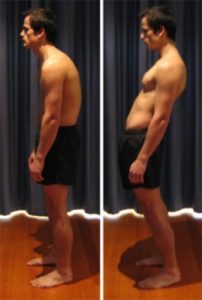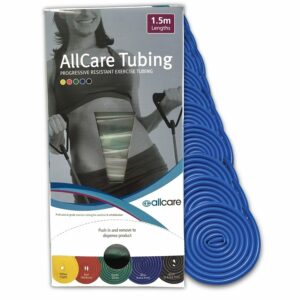Posture
Updated:
Why maintain correct posture?
When maintaining correct posture, the joints, ligaments and muscles of the neck and back are positioned optimally so they are under minimal stress. Maintaining this position reduces the likelihood of back or neck injury, which is vital in today’s society where spinal and postural pain are prevalent. Maintaining correct postural alignment helps those suffering from neck or back pain, by reducing stress on injured structures, thereby speeding healing. Furthermore, this optimal spinal position enables your muscles to generate force more efficiently which improves performance in sporting or recreational activities.
Can I change my posture?
Many people have poor postural habits that have developed over a long period of time (figures 1 & 2). Due to these habits, joints gradually tighten up, restricting spinal movement and affecting posture. As a result, obtaining correct postural alignment often feels difficult and unnatural. This can be changed with practice.


The more time you spend maintaining correct posture, the easier it becomes. This occurs for two main reasons. Firstly, your joints and muscles loosen up with maintaining this optimal spinal position so that there is less resistance from your body. Secondly, your muscle ‘memory’ improves over time, so that with enough practice, maintaining this position occurs more naturally.
It is important to remember that your ability to maintain correct postural alignment won’t develop over night. Every time you find yourself slouching, don’t give up, just think of it as a time you can correct your position and do something productive, thereby gradually breaking bad habits.
What is correct posture?
As a general rule, correct posture (or optimal spinal alignment) can be achieved by ensuring there is a straight line from your ears, to your shoulders, to your hips. Think about maintaining a tall, long spine as though a piece of string is pulling your head toward the ceiling (figure 3).

Figure 3 – Correct Standing Posture
Postural Taping can be an excellent method to encourage optimal spinal alignment and can help educate individuals as to how to maintain this position during general activity. The goal with postural taping is to keep tension off the tape at all times therefore ensuring good spinal alignment is being maintained. A Posture Support may also be used in a similar manner.
Here are some recommendations on how to achieve optimal spinal alignment in various positions:
Sitting
In sitting, it is important to have an ergonomic chair which offers firm support thereby allowing your body to maintain correct posture. Your bottom should be situated at the back of the chair and a lumbar support should be placed in the small of your back to assist with maintaining optimal spinal alignment. Your shoulders should be held back slightly and your chin should be tucked in a little (figure 4). The height of the chair should allow your hips and knees to be at right angles (it is important not to have your knees higher than the level of your hips as this may encourage slouching).

Figure 4 – Correct Sitting Posture
Office setup
When sitting at a computer desk, the goal is to organize your environment so you can easily maintain correct posture (figure 5). Provided you can touch type, your keyboard should be as close to you as possible, encouraging you to maintain this position. If you have to look at the keys, it should be as close as possible so you can look down at the keys (using your eyes only) without having to bend your neck. Your mouse, telephone and other accessories should be as close as possible to prevent you having to lean forwards to reach them. Your computer monitor should be positioned directly in front of you, at or slightly below eye level to assist with maintaining the optimal neck position.

Your chair should also be as close to the desk as possible.Regular breaks from sitting are recommended with standing, walking or lying and should occur regularly enough to prevent any onset of posture related pain.
Standing

Members Only ContentBecome a PhysioAdvisor Member to gain full access to this exclusive content. For more details see Become a Member. Already a member? Login Now
Lying

Members Only ContentBecome a PhysioAdvisor Member to gain full access to this exclusive content. For more details see Become a Member. Already a member? Login Now
Choosing a Bed for Correct Posture

Members Only ContentBecome a PhysioAdvisor Member to gain full access to this exclusive content. For more details see Become a Member. Already a member? Login Now
Common Postural Exercises

Members Only ContentBecome a PhysioAdvisor Member to gain full access to this exclusive content. For more details see Become a Member. Already a member? Login Now
Keeping Active

Members Only ContentBecome a PhysioAdvisor Member to gain full access to this exclusive content. For more details see Become a Member. Already a member? Login Now
Posture Summary

Members Only ContentBecome a PhysioAdvisor Member to gain full access to this exclusive content. For more details see Become a Member. Already a member? Login Now
 Physiotherapy Products
Physiotherapy Products
Some of the most commonly recommended products by physiotherapist for patients with postural dysfunction include:
-
 AllCare Ortho Light Back Support
AllCare Ortho Light Back Support -
 OPPO – Posture Aid / Clavicle Brace (OPP2075)
OPPO – Posture Aid / Clavicle Brace (OPP2075) -
 Premium Strapping Tape 38mm (Victor)
Premium Strapping Tape 38mm (Victor) -
 AllCare Tubing
AllCare Tubing -
 AllCare Spikey Massage Ball
AllCare Spikey Massage Ball -
 AllCare Foam Roller Round
AllCare Foam Roller Round -
 McKenzie Treat Your Own Neck Book
McKenzie Treat Your Own Neck Book -
 Dentons Impressions Classic Memory Foam Therapeutic Pillow
Dentons Impressions Classic Memory Foam Therapeutic Pillow -
 Lumbar Rolls (‘D’ Shaped)
Lumbar Rolls (‘D’ Shaped)
To purchase physiotherapy products to assist with maintaining optimal spinal alignment click on one of the above links or visit the PhysioAdvisor Shop.
 Find a Physio
Find a Physio
Find a physiotherapist in your local area who can help to correct poor spinal alignment and treat associated injuries.
 Injury Information
Injury Information
Click on the appropriate link below to view detailed injury information on some common injuries related to poor postural alignment:
- Cervical Postural Syndrome
- Thoracic Postural Syndrome
- Lumbar Postural Syndrome
- Cervical Disc Bulge
- Thoracic Disc Bulge
- Lumbar Disc Bulge
- Cervicogenic Headache
 More Information
More Information
- View Postural Taping to learn how to improve your spinal alignment with sports tape
- View Postural Exercises designed to improve your posture and spinal alignment.
- View Beginner Pilates Exercises designed to improve spinal alignment, core stability, flexibility and strength.
- View information about Ergonomic Computer Setup.
Become a PhysioAdvisor Member

Link to this Page
If you would like to link to this article on your website, simply copy the code below and add it to your page:
<a href="https://physioadvisor.com.au/health/ergonomics/posture”>Posture – PhysioAdvisor.com</a><br/>PhysioAdvisor offers expert physiotherapy information on obtaining correct posture in various positions including beneficial exercises.
Return to the top of Posture.

